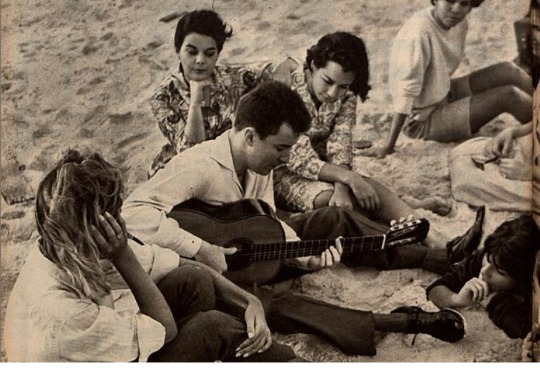#joao gilberto
Text

João Gilberto, Gal Costa & Caetano Veloso, 1971 Photo: AC
237 notes
·
View notes
Text

#astrud gilberto#the girl from ipanema#stan getz#joao gilberto#antonio carlos jobim#vinyllove#1960s#bossa nova#jazz
67 notes
·
View notes
Photo

Joao Gilberto, Astrud Gilberto and Gato Gilberto, 1960.
39 notes
·
View notes
Text

“Astrud Gilberto was just the wife of singing star João Gilberto when she entered a NYC studio in March 1963. João and Jobim were making a record with tenor saxman Stan Getz. The idea of cutting a verse on “Ipanema” in English came up, and Astrud was the only one of the Brazilians who spoke more than phrasebook English.
Astrud’s child-like vocal, devoid of vibrato and singerly mannerisms, was the perfect foil for her husband’s soft bumblebee voice. Jobim tinkled piano. Getz blew a creamy smooth tenor. Four minutes of magic went to tape.” - [x]
Brazilian Bossa Nova singer Astrud Gilberto (born Astrud Evangelina Weinert; 29 March 1940 – 5 June 2023), pictured with her first husband and sometimes duet partner João Gilberto in the 1960s.
#astrud gilberto#joão gilberto#joao gilberto#stan getz#bossa nova#antonio carlos jobim#music#1960s#1960s music#rip#girl from ipanema#the girl from ipanema
31 notes
·
View notes
Text

Over on vinyl Instagram they asked for a collaboration between artists from different cultures. I went with the bossa nova classic Getz/Gilberto, one of those perfect top to bottom albums with every element in the exact right place. This collaboration between the North American Stan Getz and the South American superstars João Gilberto and A. C. Jobim (not to mention the incredible Milton Banana on drums) reinvigorated the bossa nova trend in the States, rescuing it from “flash in the pan fad” status in the eyes of USAmericans.
11 notes
·
View notes
Video
youtube
naomi & goro with 菊地成孔「Rosinha」
5 notes
·
View notes
Text


É sol, é sal, é Sul
29 notes
·
View notes
Text
I was tagged by @corvus-pictor my beloved. [Gracias, amistad 🫂] to post 10 songs you like with names in them and then tag 10 people.
I tag @nullheaven @t74x6n83pq9sck4va0 @maesus @puppetstringed @ily2kys @nectrash @187um-killa-trill @terracottahearted @taeminnomuyeppeo @shystinkbug and @sczzzm-4v0mez in case she's back, and everyone else who wants to do it c: (let me know and I'll tag you in the future 'cause I suck at usernames)
#music taste#cradle of filth#zoe#a perfect circle#miley cyrus#dolly parton#amphibian man#joao gilberto#ricky martin#pearl jam#Clan of xymox#Spotify
17 notes
·
View notes
Text
youtube
Clásica entre clásicas, crema de la crema, "The Girl From Ipanema" / "Garota de Ipanema" para decir adiós a Astrud Gilberto, fallecida a los 83 años, una de las máximas popularizadoras de la bossa nova a nivel internacional. Una melodía de Antonio Carlos Jobim con letra en portugués de Vinicius de Moraes y en inglés de Norman Gimbel, grabada por Astrud Gilberto, João Gilberto y Stan Getz en marzo de 1963 como parte del álbum "Getz/Gilberto", lanzado un año más tarde por el sello de jazz Verve. João cantó en portugués y Astrud en inglés. La versión single alcanzó el número uno en la lista pop y fue considerada como mejor grabación del año en 1965, pero la versión larga de más de cinco minutos del LP es definitivamente superior a la más ecónomica editada en sencillo.
2 notes
·
View notes
Note
when are u making a song in spanish
i did <3 i re-imagined bésame mucho with my producer friend cowboy lansky :)
my version represents the passage of time thru music by progressively becoming more modern in production as u listen
especially with vocal production: it starts with an old mic, switches to a more modern mic, then it has a transition part where my voice sounds like a synth bc it's so auto-tuned, and lastly we use vocoder on mi voice towards the end <3
u can listen here~
5 notes
·
View notes
Text
João Gilberto - João Gilberto (1973)

Over the past few years I've watched as my idea of music slowly dematerialised. When I was 13, all good music meant to me was hard rock - there had to be riffs, there had to be a concreteness to it, vocals and lyrics that made sense, things to hold onto - songs that were just that - songs. Who can blame me?
Then, steadily over the years, as I was introduced to more experimental and foreign acts, my notion of what makes a good song began to change. I'll always find joy in a Beatles track and Dylan's long stories will always move me, but if everything except the bare minimum is stripped away, will a song still hold the same beauty? João Gilberto's (1931-2019) brave and sadly all too forgotten self-titled experiment begs you to ask yourself that very question.
This is a strange, introverted record from one musician who was, by all means, a strange, introverted man. To understand this album, you must realise Gilberto is widely held as one of the most reclusive celebrities who ever lived. His feats may have included co-founding Bossa Nova, one of Brasil's signature genres, and working on what is one of the most universally beloved albums of all time, 1963's Getz/Gilberto and yet on his end was nearly always... silence. Profoundly solitary and perfectionist with a bad case of stage-fright, Gilberto never basked in the glory of knowing he profoundly changed his country's musical identity. By the end of his very accomplished life he hardly ever left his apartment in Rio.
So, much like his life, this album is quiet, understated, soft-spoken and, above all, an entirely mesmerising experiment. It's as if you're sitting there watching him strum along with his guitar in the quietude of a Brazilian night, sometimes mumbling lyrics he remembers to his own unique rhythm, sometimes improvising if nothing comes to mind.
The first track, Águas de Março, is a staple of Brazilian music. You've probably heard Jobim and Regina delightful rendition of it, a warm, fun and flirtatious duet, or maybe you've heard Art Garfunkel's controversial cover in English. Gilberto's version, however, has a staggeringly different atmosphere to both of these. Gone are the pleasant tempos of Jobim and synths of Garfunkel's. This is a hurried, minimal, unfamiliar and, again, desolate track whose colder and more discreet vibe contrasts in a striking manner with Gilberto's warm voice. It establishes right away that this is no typical Bossa Nova, MPB or Samba record - this is Gilberto at his rawest, most intimate and genuine. Other standouts include the gorgeous Avarandado, Falsa Baiana and É Preciso Perdoar.
But Gilberto's magnum opus, the thing that solidified him as one of the most brilliant musicians I have ever known, comes second on the album: the confounding Undiú. It's hard for me to find words for a song that itself only uses one, so I won't try. Just allow yourself to not pay attention to anything else for those six minutes.
Notice every minor detail there, the mild fluctuations in his voice, his gentle lull. Don't take the sparseness of this record as a fault - delve into its beauty - and in that moment of trance you will understand João Gilberto.

7 notes
·
View notes
Text





Un Día Como Hoy junio10 de 1931 nació en Juazeiro, Bahia, el guitarrista y cantante brasileiro Joao Gilberto de Oliveira, quien es precursor del Bossa Nova con Vinicius de Moraes y Antonio Carlos Jobim, con este último grabo en 1963 Garota de Ipanema con Stan Getz y Astrud Gilberto, tema más famoso del género.
14 notes
·
View notes
Text

João Gilberto (RIP), Gal Costa (RIP) e Caetano Veloso. Esses três cantores brasileiros estão na lista da revista Rolling Stone dos 200 Melhores Cantores de Todos os Tempos.
João Gilberto (RIP), Gal Costa (RIP) and Caetano Veloso. These three brazilian singers are on Rolling Stone magazine's list of the 200 Greatest Singers of All Time.
#joao gilberto#gal costa#caetano veloso#mpb#tropicalia#bossa nova#brazilian music#rolling stone#magazine#200 best singers of all time#list#brazil#brasil
3 notes
·
View notes



